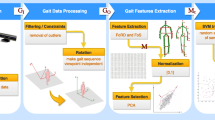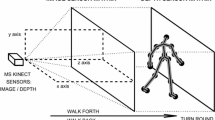Abstract
A persons manner of walking or their gait is an important feature in human recognition and classification tasks. Gait serves as an unobtrusive biometric modality which yields high quality results. In comparison with other biometric modalities, its main strength is its performance even in data that are captured at distance or at low resolution. In this paper, we present an algorithm for classification of gait disorders arising from neuro-degenerative diseases such as Parkinson and Hemiplegia. We focus on motion anomalies such as tremor, partial paralysis, gestural rigidity and postural instability. The analysis and classification of such motions are challenging since they consist of a multiplicity of subtle formations while lacking a regular pattern or major cycle. We introduce a gait representation which is invariant to the walking cycle and yields an efficient similarity metric. Our method performs on the joints’ motion trajectories of a 3D human skeleton captured by a Kinect sensor. The algorithm is robust, in that it does not require calibration, synchronization or a careful capturing setup. We demonstrate its efficiency by classifying different degenerative cases with high accuracy even in the presence of noise and low-resolution acquisition.






Similar content being viewed by others
References
Ahmed, M., Al-Jawad, N., Sabir, A.: Gait recognition based on kinect sensor. In: SPIE Photonics Europe, International Society for Optics and Photonics, pp. 91390B–91390B (2014)
Akae, N., Mansur, A., Makihara, Y., Yagi, Y.: Video from nearly still: an application to low frame-rate gait recognition. In: 2012 IEEE Conference on Computer Vision and Pattern Recognition, Providence, RI, USA, pp. 1537–1543, 16–21 June 2012 (2012)
Ball, A., Rye, D., Ramos, F., Velonaki, M.: Unsupervised clustering of people from skeleton data. In: Proceedings of the 7th Annual ACM/IEEE International Conference on Human–Robot Interaction, pp. 225–226. ACM (2012)
Boulgouris, N.V., Plataniotis, K.N., Hatzinakos, D.: Gait recognition using dynamic time warping. In: Multimedia Signal Processing, 2004 IEEE 6th Workshop on, pp. 263–266. IEEE (2004)
Brodal, P.: The Central Nervous System: Structure and Function. Oxford University Press, Oxford (2010)
Chattopadhyay, P., Sural, S., Mukherjee, J.: Gait recognition from front and back view sequences captured using kinect. In: Pattern Recognition and Machine Intelligence, pp. 196–203. Springer, New York (2013)
Cippitelli, E., Gasparrini, S., Spinsante, S., Gambi, E.: Kinect as a tool for gait analysis: validation of a real-time joint extraction algorithm working in side view. Sensors 15(1), 1417–1434 (2015)
Dikovski, B., Madjarov, G., Gjorgjevikj, D.: Evaluation of different feature sets for gait recognition using skeletal data from kinect. In: Information and Communication Technology, Electronics and Microelectronics (MIPRO), 2014 37th International Convention on, pp. 1304–1308. IEEE (2014)
Förstner, W., Moonen, B.: A metric for covariance matrices. In: Grafarend, E.W., Krumm, F.W., Schwarze, V.S. (eds.) Geodesy-the Challenge of the 3rd Millennium, pp. 299–309. Springer, Berlin (2003). doi:10.1007/978-3-662-05296-9_31
Gabel, M., Gilad-Bachrach, R., Renshaw, E., Schuster, A.: Full body gait analysis with kinect. In: Engineering in Medicine and Biology Society (EMBC), 2012 Annual International Conference of the IEEE, pp. 1964–1967. IEEE (2012)
Galna, B., Barry, G., Jackson, D., Mhiripiri, D., Olivier, P., Rochester, L.: Accuracy of the microsoft kinect sensor for measuring movement in people with parkinson’s disease. Gait Posture 39(4), 1062–1068 (2014)
Han, J., Bhanu, B.: Individual recognition using gait energy image. Pattern Anal. Mach. Intell. IEEE Trans. 28(2), 316–322 (2006)
Hausdorff, J.M., Lertratanakul, A., Cudkowicz, M.E., Peterson, A.L., Kaliton, D., Goldberger, A.L.: Dynamic markers of altered gait rhythm in amyotrophic lateral sclerosis. J. Appl. Physiol. 88(6), 2045–2053 (2000)
Hausdorff, J.M., Rios, D.A., Edelberg, H.K.: Gait variability and fall risk in community-living older adults: a 1-year prospective study. Arch. Phys. Med. Rehabil. 82(8), 1050–1056 (2001)
Johansson, G.: Visual Motion Perception. Freeman, Scientific American off prints (1975)
Kahn, T., Nyholm, D.: Computer vision methods for parkinsonian gait analysis: a review on patents. Recent Patient Biomed. Eng. 2013(6), 97–108 (2013)
Kanade, T., Khan, S., Akhter, I., Sheikh, Y.: Trajectory space: a dual representation for nonrigid structure from motion. IEEE Trans. Pattern Anal. Mach. Intell. 33, 1442–1456 (2010). doi:10.1109/TPAMI.2010.201
Keijsers, N.L., Horstink, M.W., Gielen, S.C.: Ambulatory motor assessment in Parkinson’s disease. Mov. Disord. 21(1), 34–44 (2006)
Kumar, M., Babu, R.V.: Human gait recognition using depth camera: a covariance based approach. In: Proceedings of the 8th Indian Conference on Computer Vision, Graphics and Image Processing, pp. 20. ACM (2012)
Lam, T.H., Lee, R.S., Zhang, D.: Human gait recognition by the fusion of motion and static spatio-temporal templates. Pattern Recogn. 40(9), 2563–2573 (2007)
Lee, L., Grimson, W.E.L.: Gait analysis for recognition and classification. In: Automatic Face and Gesture Recognition, 2002. Proceedings, 5th IEEE International Conference on, pp. 148–155. IEEE (2002)
Li, X., Maybank, S.J., Yan, S., Tao, D., Xu, D.: Gait components and their application to gender recognition. Syst. Man. Cybern. Part C: Appl. Rev. IEEE Trans. 38(2), 145–155 (2008)
Liu, L.-F., Jia, W., Zhu, Y.-H.: Survey of gait recognition. In: Emerging Intelligent Computing Technology and Applications. With Aspects of Artificial Intelligence, pp. 652–659. Springer, New York (2009)
Lu, J., Wang, G., Huang, T.S.: Gait-based gender classification in unconstrained environments. In: Proceedings of the 21st International Conference on Pattern Recognition, ICPR 2012, Tsukuba, Japan, November 11–15, 2012, pp. 3284–3287 (2012)
Lu, J., Wang, G., Moulin, P.: Human identity and gender recognition from gait sequences with arbitrary walking directions. Inf. Forens. Secur. IEEE Trans. 9(1), 51–61 (2014)
Makihara, Y., Mannami, H., Yagi, Y.: Gait analysis of gender and age using a large-scale multi-view gait database. In: Computer Vision–ACCV 2010, pp. 440–451. Springer, New York (2011)
Mansur, A., Makihara, Y., Aqmar, R., Yagi, Y.: Gait recognition under speed transition. In: Proceedings of the 2014 IEEE Conference on Computer Vision and Pattern Recognition, CVPR ’14, pp. 2521–2528 (2014)
Martín-Félez, R., Xiang, T.: Gait recognition by ranking. In: Computer Vision - ECCV 2012 - 12th European Conference on Computer Vision, Florence, Italy, October 7–13, 2012, Proceedings, Part I, pp. 328–341 (2012)
Murase, H., Sakai, R.: Moving object recognition in eigenspace representation: gait analysis and lip reading. Pattern Recogn. Lett. 17(2), 155–162 (1996)
Ng, C.B., Tay, Y.H., Goi, B.-M.: Recognizing human gender in computer vision: a survey. In: PRICAI 2012: Trends in Artificial Intelligence, pp. 335–346. Springer, New York (2012)
Parajuli, M., Tran, D., Ma, W., Sharma, D.: Senior health monitoring using kinect. In: Communications and Electronics (ICCE), 2012, 4th International Conference on, pp. 309–312. IEEE (2012)
Rocha, A.P., Choupina, H., Fernandes, J.M., Rosas, M.J., Vaz, R., Cunha, S., Paulo, J.: Parkinson’s disease assessment based on gait analysis using an innovative rgb-d camera system. In: Engineering in Medicine and Biology Society (EMBC), 2014 36th Annual International Conference of the IEEE, pp. 3126–3129. IEEE (2014)
Fahn, P.J.S., Mardsen, C.D., Teychenne, P.: Recent Developments in Parkinson’s Disease. American Neurological Association (1987)
Shotton, J., Fitzgibbon, A., Cook, M., Sharp, T., Finocchio, M., Moore, R., Kipman, A., Blake, A.: Real-time human pose recognition in parts from single depth images. In: Proceedings of the 2011 IEEE Conference on Computer Vision and Pattern Recognition, CVPR ’11, pp. 1297–1304 (2011)
Sivapalan, S., Chen, D., Denman, S., Sridharan, S., Fookes, C.: Gait energy volumes and frontal gait recognition using depth images. In: 2011 International Joint Conference on Biometrics (IJCB), pp. 1–6. IEEE (2011)
Stone, E.E., Skubic, M.: Passive in-home measurement of stride-to-stride gait variability comparing vision and kinect sensing. In: Engineering in Medicine and Biology Society, EMBC, 2011 Annual International Conference of the IEEE, pp. 6491–6494. IEEE (2011)
Stone, E.E., Skubic, M., Back, J.: Automated health alerts from kinect-based in-home gait measurements. In: Engineering in Medicine and Biology Society (EMBC), 2014 36th Annual International Conference of the IEEE, pp. 2961–2964. IEEE (2014)
Tang, J., Luo, J., Tjahjadi, T., Gao, Y.: 2.5 Days multi-view gait recognition based on point cloud registration. Sensors 14(4), 6124 (2014)
Uddin, M.Z., Kim, J.T., Kim, T.-S.: Depth video-based gait recognition for smart home using local directional pattern features and hidden markov model. Indoor Built Environ. 23(1), 133140 (2014)
Vemulapalli, R., Arrate, F., Chellappa, R.: Human action recognition by representing 3d skeletons as points in a lie group. In: Computer Vision and Pattern Recognition (CVPR), 2014 IEEE Conference on, pp. 588–595. IEEE (2014)
Acknowledgements
This project was sponsored by National 973 Program (No. 2015CB352500), National Natural Science Foundation of China (No. 61503217), Shandong Provincial Natural Science Foundation of China (No. ZR2014FP002), and the Fundamental Research Funds of Shandong University (No. 2014TB005, 2014JC001).
Author information
Authors and Affiliations
Corresponding author
Rights and permissions
About this article
Cite this article
Li, Q., Wang, Y., Sharf, A. et al. Classification of gait anomalies from kinect. Vis Comput 34, 229–241 (2018). https://doi.org/10.1007/s00371-016-1330-0
Published:
Issue Date:
DOI: https://doi.org/10.1007/s00371-016-1330-0




